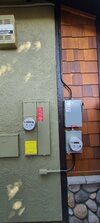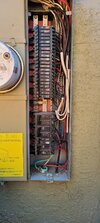I'm going to add my own energy monitoring system (emporia) since I didn't get one when my panels were installed. I'd rather not turn the power off at the Inverter and I don't think it matters where I disconnect but I thought I'd check in here what the standard practice is. Perhaps I do need to turn both the disconnect and the inverter off, and by disconnect I'm talking about the one on the right in the attached picture.
-
Want to remove ads? Register an account and login to see fewer ads, and become a Supporting Member to remove almost all ads.
Adding Breakers to Panel, Turn Off Inverter or Disconnect?
- Thread starter GeorgeIoak
- Start date




